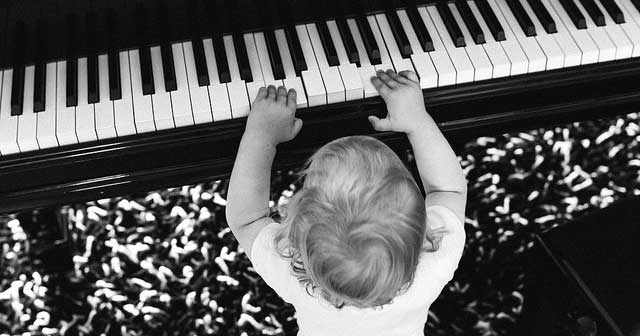
It’s a cliché of anxious, middle-class parenting: if you want your baby to have a real shot in life, there’d better be a violin in her hands before she’s three. And like many clichés, there appears to be some truth to the sentiment. Plenty of researchers are convinced that early musical training can pay dividends later in life—and language is often singled out as one of the biggest beneficiaries of these musical forays.
I’d always assumed that the relationship between music and language stemmed from a shared dependence on hierarchical structure: like language, music is governed by a complex set of rules, and rules within rules, to be internalized, mastered, and eventually, perhaps, (playfully) broken. Learning a language while learning an instrument, then, ought to help with mastery of both—cross-training for the mind.
But there’s another, less obvious similarity between language and music: rhythm. Even before they’re born, babies are sensitive to rhythm, spending their days in utero familiarizing themselves with the telltale beats of their native language. The sensitivity to rhythm continues throughout early childhood, as children use patterns in stressed and unstressed syllables to help determine, for instance, where one word ends and another begins.
But some children have better rhythm than others, with interesting consequences. In one recent study, preschoolers who were able to match an experimenter’s steady beat on a conga drum were also found to have better language skills than non-synchronizers: they named objects faster, had better auditory memories, and scored more highly on tests of phonological awareness (which require you to manipulate sounds: saying frog without pronouncing the r, for instance). In another recent study, the ability to discriminate rhythmic patterns in kindergarten was tied to better phonological awareness skills in second grade.
Why? In many ways, timing is as important in language as it is in music. I mentioned before that patterns of stressed and unstressed syllables can indicate word boundaries; more fine-grained timing (on the order of milliseconds) can help us determine whether we’ve heard a b or a d. Music and language, then, may well tap into “shared neural resources for temporal precision,” according to the researchers.
And sensitivity to rhythmic patterns on a larger scale may even aid our grammar. Yet another recent study had six-year-olds listen to sequences of beats—bam ba da bam__da bam bam ba da!—and decide whether they were the same as, or different than, earlier sequences. Then the children answered a variety of questions designed to test their grammatical knowledge: what the past tense of bring is, for instance, or when him versus himself should be used in a sentence.
Rhythmic ability was positively related to grammatical knowledge—even when other factors, including socioeconomic status, IQ, and prior musical training were taken into account. “Children who have stronger musical rhythm discrimination skills may also be more sensitive in general to speech rhythm variations that mark grammatical events,” the researchers write.
This helps explain our (or at least my) response to the occasional unwieldy sentence. We repeat it aloud, again and again. How should it sound? Am I missing something?

